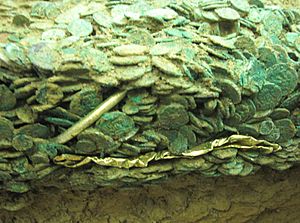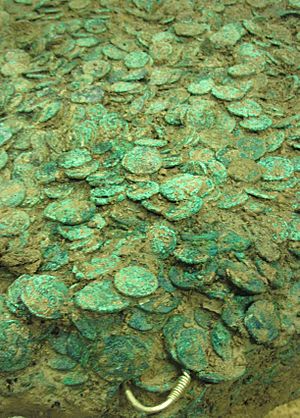Grouville Hoard facts for kids
The Grouville Hoard is a very large collection of ancient coins and jewelry. It was found in June 2012 in a field in Grouville, a place on the island of Jersey in the Channel Islands. Experts believe there are about 70,000 coins from the late Iron Age and Roman times.
This amazing discovery was made by two metal detectorists, Reg Mead and Richard Miles. It's the biggest treasure ever found in Jersey. It's also the first major archaeological find there made by people using metal detectors.
Historians think the hoard belonged to a group called the Curiosolitae tribe. They might have buried it while running away from Julius Caesar's armies. This would have happened around 50 to 60 BC.
Contents
How the Hoard Was Found
Reg Mead and Richard Miles started looking for treasure in the area in the early 1980s. They had heard a story about a farmer who found some silver coins years before. The farmer found them in a pot while pulling out a tree from a hedgerow.
The exact spot was a secret, and the farm owner only let them search once a year. They could only look for 10 to 15 hours after the crops were picked. Because of this, it took them about 30 years to finally find the treasure!
In early 2012, Mead and Miles first found 60 silver and one gold Iron Age coin. These coins might have been made by the Curiosolitae tribe in France. After finding these, they kept searching nearby. Soon, they discovered a huge lump of coins stuck together in clay.
The two men told Jersey Heritage about their amazing find. In June 2012, archaeologists came to help. They carefully removed the large clay mass of coins. It measured about 140 by 80 by 20 centimeters (55 by 31 by 8 inches). It weighed about 750 kilograms (1,650 pounds)! This huge lump was taken to the Jersey Archive. There, experts are slowly cleaning and preserving it.
What Was Inside the Hoard?

As experts clean and examine the hoard, they are finding many different items. So far, they have removed individual pieces from the clay.
Besides the estimated 70,000 Celtic and Roman silver coins, the hoard also contains beautiful jewelry. They have found gold torcs (necklaces), silver bracelets, thin gold sheets, and fine silver wire. There are also a number of colorful glass beads.
Why Was the Treasure Buried?
Archaeologists also dug up the pit where the large hoard was found. They discovered signs of wooden posts, which might have been from a small hut. They also found a lot of burnt clay and pieces of old pottery. These items are from the late Iron Age and early Roman times.
Some of the coins found were cut in half. There were also signs of slag and furnace linings. This suggests that people might have been melting down coins in this spot. It's possible that new coins were being made there. The tribe might have buried the treasure to keep it safe from invaders.
Seeing the Grouville Hoard Today
The work to clean and preserve the hoard is still happening. Some parts of the hoard were shown in an exhibition at the Jersey Museum. This display ran from May 26 to December 31, 2014.
Since 2015, parts of the Grouville Hoard have been on display. You can see them at the La Hougue Bie Museum in Jersey.
How Much Is the Hoard Worth?
The two people who found the hoard and the landowner made an agreement. They decided to share any money made from the treasure. They hope that the coins will eventually be shown to the public. They would like them to be displayed at the Jersey Museum or the Jersey Archive.
An expert on Celtic coins, Philip de Jersey, has given an idea of the hoard's value. He thinks each coin could be worth between £100 and £200. This means the entire hoard might be worth between £7 million and £14 million!


